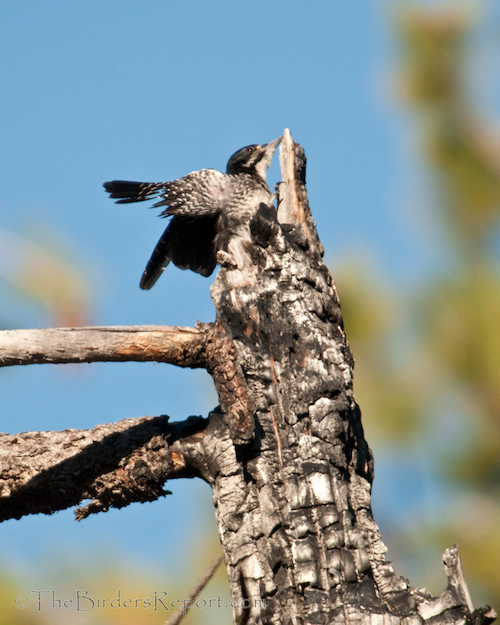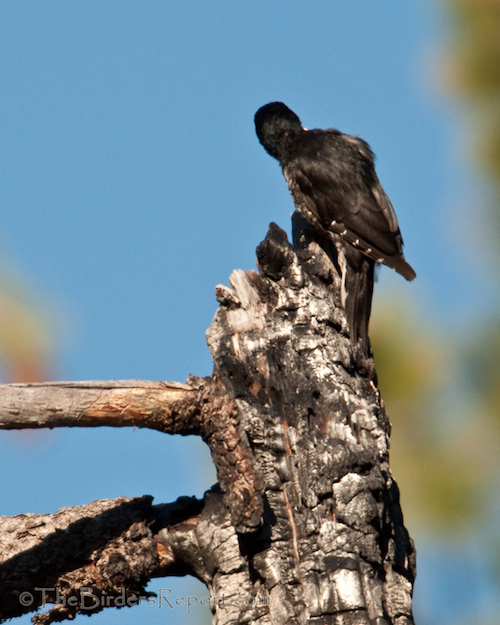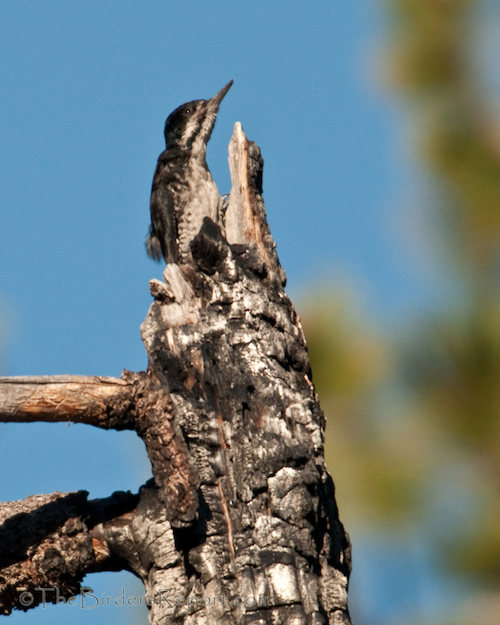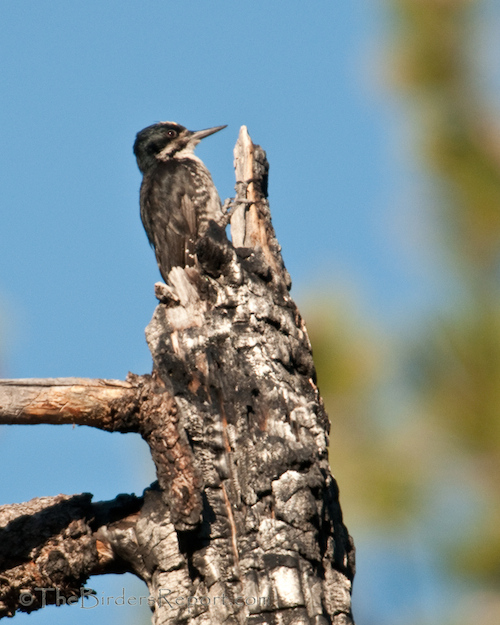Black-backed Woodpecker (Picoides arcticus) Male photos by Larry Jordan
I arrived at Lassen Volcanic National Park around 7:00 a.m. It was a cool 48 degrees. I had taken the short drive to the park to search for a family of American Dippers sighted near the visitor center by a fellow birder a few days before. What I found was more than I could possibly hope for.
I parked where I nearly always begin my day at Lassen Park, at the first turn out about 100 yards beyond the northern park entrance ranger station off highway 44. As I got out of my car, about fifty feet from Manzanita Lake, I heard the loud drumming of a woodpecker. Click on photos for full sized images.
I didn’t know what species of woodpecker it was, but I knew it was just in the clearing on the other side of the road. I grabbed my bins, camera and camcorder and headed toward the hollow drumbeat. If not for the drumming, I would probably not have seen the Black-backed Woodpecker (Picoides arcticus), listed by authors of some field guides as “scarce,” by others as “uncommon to rare.”
Note how well camouflaged this bird is atop a snag in its natural habitat of burned coniferous forest.
I approached carefully as I listened to the ever growing sound of the drumming, not wanting to flush a bird I had only seen once before.
Black-backed Woodpeckers are non-migratory, although there have been documented intermittent irruptions of the species outside their normal range. Some of theseirruptions have been attributed to a lack of wood-boring insect prey on their normal range or to overpopulation following an insect outbreak1.
Either way, they are usually due to exploitation of wood-boring beetle larvae, their primary food. Range map courtesy of South Dakota Birds and Birding.

The Black-backed Woodpecker and its cousin the Three-toed Woodpecker are the only North American land birds with three toes instead of the usual four.
Since their primary food is wood-boring insect larvae, these woodpeckers have adapted skulls that are highly adapted for pounding, as you probably noticed in the video
Drumming is used by woodpeckers to attract a mate or declare a territory. Since drumming is normally used to communicate over long distances, woodpeckers use surfaces with good acoustic properties like hollow branches or trunks to pound on.
Both the male and female Black-backed Woodpeckerdrum, and most frequently in the Spring, to attract a mate.
I’m not sure why this guy was drumming but as you saw in the video, he would drum and then appear to be listening for a return signal?
Apparently it is also common for Black-backed Woodpeckersto stretch and preen between drumming episodes.
Whenever I visit Lassen Volcanic National Park, I always search for nesting woodpeckers. A few years ago my friend Jim Arnold photographed a nesting Black-backed Woodpeckerin the parkat Hat Lake. You can see his excellent photo of the nestling here.
Stay tuned for photos of the American Dippers (or Water Ouzelsas I like to call them) and the Brown CreepersI saw later that day in upcoming posts.
If you want to see more great bird photos from around the world, check out World BirdWednesday!
References: 1Birds of North America Online
Larry Jordan
Larry Jordan is an avid birder and amateur photographer living on the Pacific Flyway near the Central Valley of Northern California. He is a board member of his local Audubon Society and is a bird and wildlife conservationist. Larry contributes to several wildlife conservation organizations and is a BirdLife International "Species Champion." He is also Habitat Manager for the Burrowing Owl Conservation Network, an organization dedicated to the protection and restoration of the Western Burrowing Owl population in the United States. Larry has been blogging about birds since September of 2007 at TheBirdersReport.com










Leave a Reply